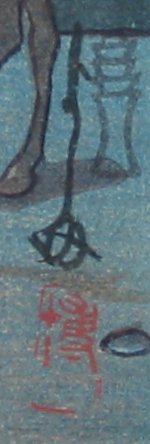
JAPANESE PRINTS
A MILLION QUESTIONS
TWO MILLION MYSTERIES
Ukiyo-e Prints浮世絵版画 |
|
Port Townsend, Washington |
| HIROSHI YOSHIDA |
| 吉田博 |
| よしだひろし |
| 1876-1950 |
| "The Sphinx at Night" |
| スフィンクス 夜 (よ) |
| "Sufuinkusu" |
| 1925 |
| The blocks were cut by Watanabe. |
| SOLD |
|
|
 |
|||
| The odd image next to the signature is referred to as the Egyptian "ded" column in outline. |
|
THE JAPANESE AND THE SPHINX A FEW THOUGHTS |
||
|
Decades before it became commonplace to see hordes of Japanese tourist snapping photos of the world’s most famous sites Yoshida traveled the world like no Japanese artist before him. This man was a traveling fool --- no disrespect intended. At 23 he made his first of several trips to the United States. But he didn’t just come here. He traveled the world. His prints include images of Yosemite’s El Capitan, Niagara Falls, the Swiss Alps, the Acropolis, the Taj Mahal, et al. He even did an image of Mt. Rainier which when sold in the Northwest reaches phenomenal prices. |
||
|
When I graduated from college I went to Europe for four months. I went everywhere and saw as much as I could. And, I kept falling in love. One of those times I met a young American woman who was traveling with a friend. We agreed to rendezvous for a trip down the Rhine from Coblenz the next day. Unfortunately, I got on the wrong boat where the crew was German and all of the passengers were Japanese except for me. I started drinking beer early and hard. The Japanese weren't drinking at all --- nor were any of them speaking in English. After a while my fellow travelers started posing me with one group after another. They seemed more interested in taking my photo than looking for the Lorelei. But what do I know --- I was drunk. However, what I can tell you is that I must be in a thousand photos in a couple of hundred albums in Japan with a lot of people wondering years later: "Who is that goofy looking guy?" One last note: the girl with whom I was smitten did sail by on another boat. We waved. |
||
|
|
||
|
Above is a detail of a print by Seishu Asahi from 1933. Perhaps he had seen Yoshida's prints. Asahi is also making an obvious reference to Hiroshige's "Naito-Shinjuku in Yotsuya" from "100 Views of Edo." |
||
 HOME
HOME